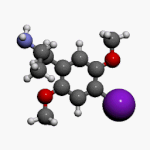2,5-Dimethoxy-4-iodoamphetamine

| |

| |
| Names | |
|---|---|
| Preferred IUPAC name
1-(4-Iodo-2,5-dimethoxyphenyl)propan-2-amine | |
| Identifiers | |
| |
3D model (
JSmol ) |
|
| ChEMBL | |
| ChemSpider | |
IUPHAR/BPS |
|
PubChem CID
|
|
| UNII | |
CompTox Dashboard (EPA)
|
|
| |
| |
| Properties | |
| C11H16INO2 | |
| Molar mass | 321.1558 g/mol |
| Melting point | 201.5 °C (394.7 °F; 474.6 K) (hydrochloride) |
| 10 mg/mL[1] | |
| Pharmacology | |
| Legal status |
|
Except where otherwise noted, data are given for materials in their standard state (at 25 °C [77 °F], 100 kPa).
| |
2,5-Dimethoxy-4-iodoamphetamine (DOI) is a
Research
Research[5] suggests that administration of (R)-DOI blocks pulmonary inflammation, mucus hyper-production, airway hyper-responsiveness and turns off key genes in in-lung immune response. These effects block the development of allergic asthma in a mouse model.
Several
Pharmacology
| Receptor | Ki (racemic DOI)[9][failed verification] | Ki (R-DOI)[9][failed verification] | Ki (S-DOI)[9][failed verification] | Intrinsic activity[10] |
|---|---|---|---|---|
| 5-HT1A | 2355 nM | 3843 nM | ND | ND |
| 5-HT1B | 1261 nM | ND | ND | ND |
| 5-HT1D | 1241.3 nM | ND | ND | ND |
| 5-HT1E | 2970 nM | ND | ND | ND |
| 5-HT1F | 2125.44 nM | ND | ND | ND |
| 5-HT2A | 0.68 nM | 0.65 nM | 0.65 nM | Partial agonist. |
| 5-HT2B | 20.03 nM | 53.70318 nM | 28.183829 nM | Partial agonist/full agonist |
| 5-HT2C | 2.38 nM | 5.370318 nM | 8.317638 nM | Full agonist when coupled to phospholipase A. Partial agonist (intrinsic efficacy = 53%), when coupled to phospholipase C. |
| 5-HT5A | 1000 nM | ND | ND | ND |
| 5-HT6 | >10000 nM | ND | ND | ND |
DOI is a 5-HT2A, 5-HT2B and 5-HT2C receptor agonist.[10]
DOI has been shown to be an extremely potent
DOI has also been shown to induce rapid growth and reorganization of
History
DOI was first synthesized by
In January 2007, British police reported that three young men had fallen ill, reportedly, after taking DOI at a rave in
Legal status
Australia
The Standard for the Uniform Scheduling of Medicines and Poisons (SUSMP) of Australia does not list DOI as a prohibited substance.[14]
Canada
Listed as a Schedule 1[15] as it is an analogue of amphetamine.[16] The CDSA was updated as a result of the Safe Streets and Communities Act, changing amphetamines from Schedule 3 to Schedule 1.[17]
Denmark
Illegal since 8 April 2007.[18]
Finland
DOI is classified as a psychoactive substance banned from the consumer market in Finland.[19]
Sweden
Sveriges riksdag added DOI to schedule I ("substances, plant materials and fungi which normally do not have medical use") as narcotics in Sweden as of August 30, 2007, published by Medical Products Agency in their regulation LVFS 2007:10 listed as DOI, 4-jod-2,5-dimetoxi-amfetamin.[20]
United States
As of 2023, DOI is not scheduled in the United States,
DOI is regularly used in animal and in vitro research.[23] Scheduling DOI could cause problems for medical researchers.[22]
US State of Florida
DOI is a Schedule I controlled substance in the state of Florida.[24]
See also
- 2,5-Dimethoxy-4-Substituted Amphetamines
- DOF
- DOB
- DOC
References
- ^ "D101 DOI hydrochloride ≥98% (HPLC), solid". Retrieved 13 April 2008.
- ^ Anvisa (2023-07-24). "RDC Nº 804 - Listas de Substâncias Entorpecentes, Psicotrópicas, Precursoras e Outras sob Controle Especial" [Collegiate Board Resolution No. 804 - Lists of Narcotic, Psychotropic, Precursor, and Other Substances under Special Control] (in Brazilian Portuguese). Diário Oficial da União (published 2023-07-25). Archived from the original on 2023-08-27. Retrieved 2023-08-27.
- ^ ISBN 978-0963009609. Archivedfrom the original on 2014-10-27. Retrieved 2014-12-17.
- ^ "LSD Blotter Acid Mimics (Actually containing 4-IODO-2,5-DIMETHOXYAMPHETAMINE (DOI) and 4-CHLORO-2,5-DIMETHOXYAMPHETAMINE (DOC)) in Lantana, Florida". DEA Microgram Bulletin. Washington, DC: Office of Forensic Sciences, Drug Enforcement Administration. June 2008. Archived from the original on 2009-02-04. Retrieved 12 February 2009.
- ^ "LSU Health New Orleans research finds psychedelic drug prevents asthma development in mice". EurekAlert!.
- S2CID 23264746.
- S2CID 25374241.
- PMID 20048135.
- ^ a b c Roth, BL; Driscol, J (12 January 2011). "PDSP Ki Database". Psychoactive Drug Screening Program (PDSP). University of North Carolina at Chapel Hill and the United States National Institute of Mental Health. Archived from the original on 8 November 2013. Retrieved 4 March 2014.
- ^ PMID 22517680.
- S2CID 25374241.
- PMID 19889983.
- ^ "New drug alert as three taken ill". BBC News. 29 January 2007.
- ^ Gill, A (22 July 2013). "POISONS STANDARD 2013" (PDF). Therapeutic Goods Administration. Australian Government Department of Health and Ageing. Retrieved 4 March 2014.
- ^ "Controlled Drugs and Substances Act : Legislative history · Schedule I · Section 19: Tramadol [Proposed]; Amphetamines". isomerdesign.com. Archived from the original on 2022-03-31. Retrieved 2012-11-27.
- ^ "Controlled Drugs and Substances Act : Definitions and Interpretations". isomerdesign.com. Archived from the original on 2013-11-10. Retrieved 2012-11-27.
- ^ [1] (in English)
- ^ "Erowid DOC Vault : Legal Status". www.erowid.org.
- ^ https://www.finlex.fi/fi/laki/ajantasa/2014/20141130
- ^ "Läkemedelsverkets föreskrifter - LVFS och HSLF-FS | Läkemedelsverket" (PDF).
- ^ "PART 1308 - Section 1308.11 Schedule I". www.deadiversion.usdoj.gov. Archived from the original on 2009-08-27. Retrieved 2014-12-17.
- ^ a b "Schedules of Controlled Substances: Placement of 2,5-dimethoxy-4-iodoamphetamine (DOI) and 2,5-dimethoxy-4-chloroamphetamine (DOC) in Schedule I". www.regulations.gov.
- PMID 34686347.
- ^ "Statutes & Constitution :View Statutes : Online Sunshine". leg.state.fl.us.
